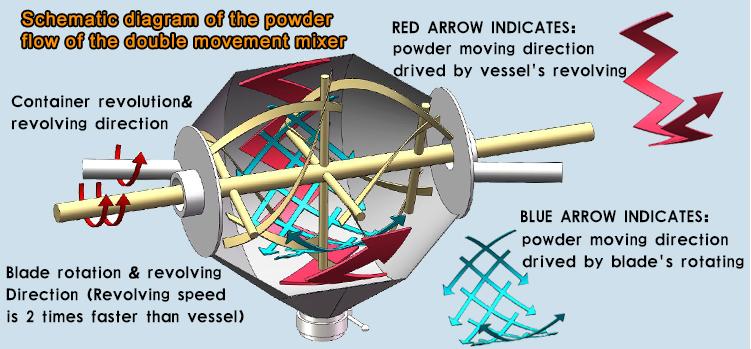
Technical consultation:
sales@drymixer.com
- 1. High Uniformity
- 2. Short mixing time,High Efficiency
- 3. 80% loading rate
- 4. Time saving,Energy saving,Space saving,Money saving.
- 5 Small damage to the original appearance of powders.
- 6. Solve the problem of ultra-fine powder mixing.
- 7. Solve the problem of light-heavy powder mixing.
- 8. Effectively solve the problem of uniform mixing diffuculty of trace elements

- 1. The important factor influenci
- 2. Particle size - an important
- 3. Powder fluidity is a double-edged sword
- 4. Pretreatment of powder mixture
- 5. Powder mixing principle introduce
- 6. Traditional powder mixers' adv
- 7. Selection of blending equipment
- 8. The basis of the uniform blending of powder
- 9. How to find the cause of mixing bad uniformity
- 10. Super light powder mixing precautions
- 11. Super fine powder mixing precautions
- 12. How to mix bad liquidity powder?
- 13. How to mix trace elements
- 14. A solution for powder's good
- 15. How does the dummy particles

Tech KnowledgeTechnical
How to avoid secondary anti-uniformity in dry powder mixture?
input time:2022-03-03 10:33:06 hits:

How to avoid secondary anti-uniformity in dry powder mixture?.There are two factors that determine the secondary segregation of the material after mixing, one is the surface shape of the mixture powder, the other is the loose loading weight of the mixture powder.Because the surface shape of an individual powder particle is different, the fluidity of the particles is different. When the surface shape of the powder particle is smooth and spherical, the fluidity of the material particle is good, and the displacement of the powder particle is far away.When the surface shape of powder particles is irregular, the material particle mobility is poor, and the distance of powder particle displacement is short, which is the segregation phenomenon in mixed materials.When need mixture of loose proportion at the same time, material will also produce segregation stratification phenomenon, because than major material tend to sink at the bottom of the barrel, the proportion of small material than major material will have upward phenomenon, this is a smaller than major powder below powder in the above, this is the material segregation stratification phenomenon.
There are some ways to avoid secondary material analysis in mixer applications!The mixture of solid particles has dynamic characteristics.The particles of the material will move even if the material is stationary in the bucket or bag of the mixer.Any liquid powder has a tendency to separate.
For materials that are easy to segregation in solid powder, customers generally adopt the following four methods in solid mixer mixing:
1. Try to ensure equal density and powder particle size between different mixtures.
2. Add a small amount of liquid to the mixture to destroy the fluidity of the powder.
3. Choose the right mixing time and do not overmix.Reduce the height and time of free powder fall after mixing.
4. Shorten the process of transfer, and press the material in time after mixing.







 DIASRIOUTION NETWORK
DIASRIOUTION NETWORK